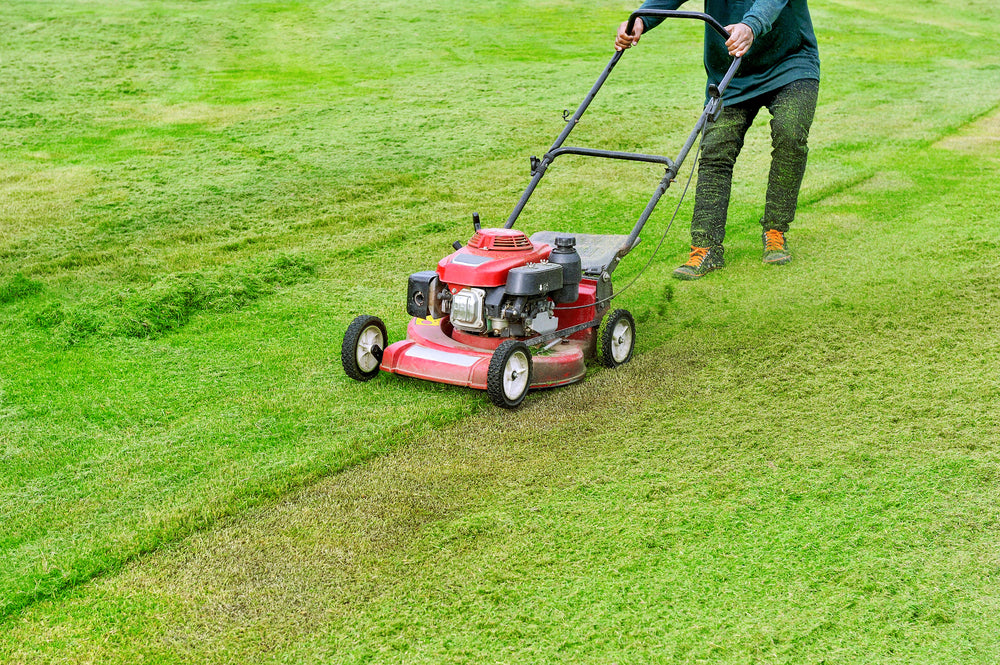Do you notice brown patches that form immediately after mowing? Is your lawn scalping after mowing?
It’s a common problem, especially with fine leaf varieties like TifTuf Bermuda and there are a few different causes to explore.
What is scalping your lawn?
‘Scalping’ your lawn is when just after mowing your lawn forms brown patches. Sometimes a lawn is scalped on purpose, like during a full spring renovation.
However, accidentally scalping your lawn can look unsightly and ruin the aesthetics of your lawn. It may also indicate some underlying issues you need to address.
What causes accidental scalping of your lawn?
There are a few different causes of brown patches forming in your lawn after mowing.
- Letting your lawn grow too long and then mowing too much off.
- Uneven levels – high and low sections of your lawn will make your mower dip into high patches.
- Thatch – a build up of thatch can make mowing difficult and can make your lawn more likely to scalp.
Repairing scalped lawn
If you have scalped small patches of your lawn, don’t worry! Most lawns will recover quickly from a small scalp.
Continue to mow at the same height regularly and ensure your lawn is getting sufficient water.
If you haven’t recently, fertilize to encourage regrowth and your lawn should repair in no time.
If scalping is occuring because you let your lawn get a bit too long or there are high levels of thatch, you can consider reseting the height of your lawn (as long as it is growing season!).
- Related topic: What A Basic Lawn Care Package In Minnesota Includes
Reset the height of your lawn
If scalping occurs from your lawn growing too long in between mows or an accumulation of thatch it is best to reset the height if your grass.
To do this, give the lawn a low mow a notch or two below your normal/preferred mowing height.
If your lawn has an accumulation of thatch, you may need to bring down the mower a few more notches to allow it to reach down into the thatch layer.
After you mow the lawn, it won’t look great at first, but it will be able to recover over the coming weeks.
During this recovery period, it is best to ensure you keep water up to the lawn. Raise your mower back up to your preferred mowing height on your next mow.
This process is best done while the lawn is actively growing throughout the warmer months and should be avoided in the cooler months while your lawn is growing at a slower rate.
After this, you will need to ensure you are frequently mowing to help avoid scalping the lawn again.
As a rule of thumb, mow your lawn frequently enough so that only one-third of the leaf is removed with each pass.
This means you will need to mow more frequently in warmer months as the grass grows faster.
Conversely, you won’t need to cut as often in the cooler months as the grass will grow slower.
Fix your lawn levels
If scalping occurs from mowing over high spots in your lawn, you can add soil/sand to amend the lawn levels. This process is known as top dressing.
When top dressing to improve levels, we recommend using sand. Something like washed plasterers’ sand or washed river sand is ideal.
When top dressing, it is best to give the lawn a low mow beforehand to ensure the top-dressing material will reach the soil profile.
Best to also ensure at most 5-10 mm thickness is applied at one time.
The sand should be rubbed in evenly using a lawn-leveller bar or the back of a rake to work the sand into the profile.
Other important mowing tips
Now you are fully equipped to help stop scalping from occurring. We have a few final tips to ensure you will get the best cut when mowing.
- Ensure your mower has sharp mower blades.
- Mow when the lawn is dry, and try to avoid mowing when the lawn is wet.
- Mow at the same length and keep it consistent.
- Switch mowing directions.
- Mow in the mornings or afternoons. Avoid mowing in the middle of the day.
- Keep at a constant pace.
If you have any further questions or you’re not sure if the brown patches are from scalping your lawn, don’t hesitate to get in touch with our lawn consultants.






